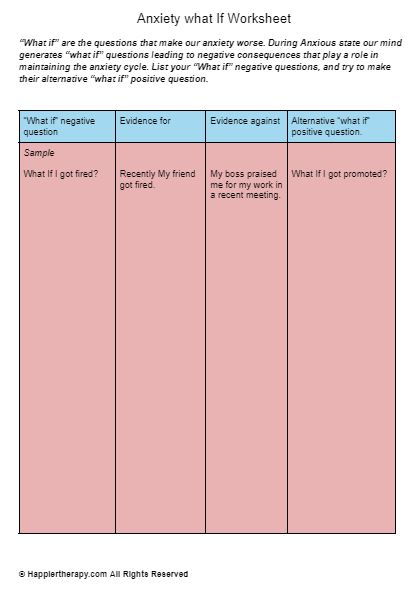Cognitive Distortions: Predicting The Future Worksheet
Premium Content
Access this worksheet and 2,500 mental health worksheets. Cancel anytime
Introduction:
According to the American Psychological Association (APA), cognitive distortion can be defined as faulty or inaccurate thinking, perception or belief. (APA, © 2022) Often at times, cognitive distortions fuel our anxiety and increase our misery.
Unlock deeper healing — upgrade to Premium now!
Customizable and fillable worksheets
Rights to alter the worksheets
Over 2000 worksheets
Support HappierTherapy
There are a number of cognitive distortions identified in Cognitive Behavioral Therapy, the most common include:
- All-or-Nothing Thinking/ Polarized Thinking
- Overgeneralization
- Mental Filters
- Catastrophizing/ Magnification or Minimization
- Mind Reading/ Jumping to Conclusions
- Predicting the Future
- Emotional Reasoning
- “Shoulds” Statements
- Labelling
10. Personalization and Blame
This particular worksheet will focus on: PREDICTING THE FUTURE.
What Are The Theories Behind This Worksheet?
Predicting the Future is one of the cognitive distortions whereby people predict negative outcomes without realistically considering the actual odds of that outcome.
People are often convinced that they know what will happen without having all the necessary information/ or facts. Example: Assuming that you will not get the job. This is a good example of predicting the future.
Predicting the future is linked to anxiety and depression and is one of the most common cognitive distortions people battle with.
People who struggle with predicting the future encounter a lot of self-torment, nervousness, and distress only because they have the perceived thoughts that something bad will happen.
Predicting the future is also called ‘fortune telling.’
How Will This Worksheet Help You?
This worksheet is targeted to help individuals make truthful appraisals of the evidence for and against predictions of the future. This is done by examining actual evidence and the quality of that evidence. (Cognitive Behavioral Therapy, ©2020)
This worksheet will also help you examine why you worry. Creating a cost-benefit analysis for this worksheet will help you distinguish whether your predictions of the future are harmful or helpful.
This worksheet will help you open yourself up to the possibility of good outcomes that are in the present.
How Should You Use This Worksheet?
Once you accept and recognize that you are predicting the future, the next step will be to reconstruct your thoughts and learn to make more logical conclusions.
There are a few strategizes that one can implement in order to avoid predicting the future. This can be done by:
- Assessing the evidence
- Considering your previous assumptions
- Considering alternative outcomes
You should use this worksheet as a guide to help you eradicate self-torment, nervousness, and distress.
This worksheet is a great self-evaluation kit.
Was this helpful?
References
1.-
American Psychological Association. (© 2022). Cognitive Distortion. Available at:
https://dictionary.apa.org/cognitive-distortion. [Accessed October 17, 2022].
2.-
Cognitive Behavioral Therapy: Los Angeles. (© 2020). Cognitive Distortion: Fortune Telling. Available at: https://cogbtherapy.com/cbt-blog/cognitive-distortion-fortune-telling. Accessed on [October 17, 2022]

 By
By

